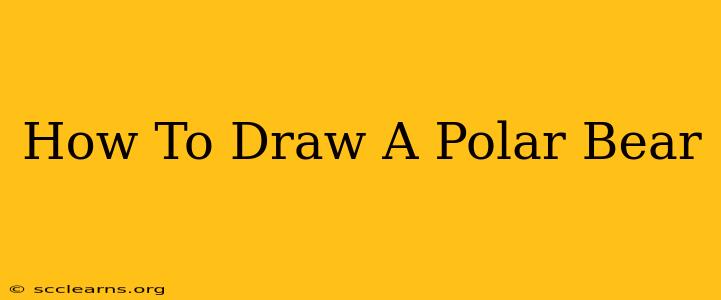Want to learn how to draw a majestic polar bear? Whether you're a seasoned artist or just starting out, this guide will walk you through the process step-by-step. We'll cover everything from basic shapes to adding those crucial details that bring your polar bear to life. Get ready to unleash your inner artist!
Getting Started: Materials You'll Need
Before we dive into the drawing process, let's gather our materials. You'll need:
- Paper: Any drawing paper will do, but thicker paper is preferable to prevent smudging.
- Pencil: A regular HB pencil is a great starting point. You might also want a darker pencil (like a 2B or 4B) for shading.
- Eraser: A good quality eraser is essential for correcting mistakes.
- Sharpener: Keep your pencils sharp for clean lines.
- Optional: Colored pencils, crayons, or paints to add color to your finished drawing.
Step-by-Step Guide to Drawing a Polar Bear
Let's begin creating your polar bear masterpiece!
Step 1: The Basic Shapes
Start by sketching a large circle for the bear's body. Then, add a smaller circle slightly overlapping the larger one – this will form the head. Connect the circles with a slightly curved line to create the neck.
Step 2: Defining the Head
Within the smaller circle (the head), sketch two smaller circles for the ears. Add a slightly curved line for the muzzle, creating a snout area below the circles. Don't worry about perfection at this stage; these are just guiding shapes.
Step 3: Adding the Limbs
Draw four oval shapes for the legs. Two larger ovals for the back legs and two smaller ovals for the front legs. Attach them to the main body circle. Consider the bear's posture – are they standing, sitting, or walking? This will influence the placement and angle of the legs.
Step 4: Refining the Details
Now it's time to refine the shapes. Connect the ovals of the legs to create more defined limbs. Carefully sculpt the head, adding a more defined nose and mouth. Remember, polar bears have a broad head and relatively short neck. Pay attention to the proportions to ensure realism.
Step 5: The Fur and Features
Polar bears have thick fur! Use short, slightly curved lines to suggest the texture of the fur. Add details to the face, such as small eyes, small ears, and a large black nose. Don't forget the claws on the paws – adding these will give your drawing a realistic touch.
Step 6: Shading and Highlights
Shading is key to giving your polar bear depth and volume. Use your darker pencil to add shadows to the areas where the fur would naturally be darker, such as under the chin, around the eyes, and under the legs. Leave lighter areas to create highlights and emphasize the fur's texture. Experiment with different shading techniques to achieve the desired effect.
Beyond the Basics: Adding Personality
Once you've mastered the basic drawing techniques, try experimenting with different poses and expressions. Consider adding a fish in the bear's mouth for a playful touch, or show them walking across a snowy landscape to add context. The more you practice, the more confident you'll become.
Tips for Success
- Practice Regularly: The key to improving your drawing skills is consistent practice.
- Study References: Look at photos of polar bears to study their anatomy and posture.
- Don't Be Afraid to Experiment: Try different techniques and styles to find what works best for you.
- Have Fun! Drawing should be an enjoyable experience. Relax, enjoy the process, and don't get discouraged by mistakes.
By following these steps and practicing regularly, you'll soon be drawing stunning polar bears! Remember to share your creations and keep exploring your artistic talents. Happy drawing!

